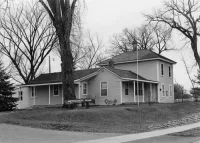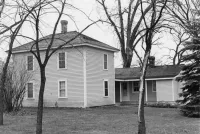Share what you know,
and discover more.
Share what you know,
and discover more.
Nov 28, 1978

-

- Charmaine Bantugan
Riley Lucas Bartholomew House - National Register of Historic Places
Statement of Significance: The Riley Lucas Bartholomew House is significant because it was the home of one of Minnesota's prominent early citizens. He was a general in the Ohio militia, a Justice of the Peace in Minnesota, a member of the Republican Constitutional Convention, a State Senator and was a volunteer in putting down the Minnesota Sioux Uprising of 1862. Riley Lucas Bartholomew was born on May 30, 1807, in Harpersfield, Ohio. He later became high sheriff of Ashtabula County, Ohio. He: Held the rank of general -in the Ohio militia. In 1852, General Bartholomew came to Minnesota, made a claim, and pitched a tent near Wood Lake (Hennepin County). He moved onto his 80 acres claim in the spring of 1853. Bartholomew then built a farm house in about 1853 and resided there for the remainder of his natural life. General Bartholomew played a vital role in the civil activities of Hennepin County and the State of Minnesota. From 1855 to 1863, Bartholomew served as Justice of the Peace in Hennepin County, Minnesota Territory. In 1857, he was a member of the Republican Constitutional Convention which framed the Minnesota State Constitution. = Two years later> he represented District 4 in the State Senate. In addition to the to the civil duties carried out. by General Bartholomew, he served in a group called "Northrup's Volunteers" during the Minnesota Sioux Uprising. As news of the event reached Minneapolis, volunteers under the command of Captain Northrop were called to aid the soldiers at Fort Ridgely. General Bartholomew died in 1894. His family and descendants continued to occupy the dwelling until 1965. Prior to that time, the property was utilized as a general produce farm. In 1965 the Richfield Public School System initiated condemnation procedures on the property for the purpose of acquiring it for expansion of their recreation facilities. The house itself was rescued from a state of dilapidation and offered to the Richfield Historical Society as headquarters for their museum. After completion of an extensive restoration program, the Historical Society transferred its collection to the house and opened it to the public.
Riley Lucas Bartholomew House - National Register of Historic Places
Statement of Significance: The Riley Lucas Bartholomew House is significant because it was the home of one of Minnesota's prominent early citizens. He was a general in the Ohio militia, a Justice of the Peace in Minnesota, a member of the Republican Constitutional Convention, a State Senator and was a volunteer in putting down the Minnesota Sioux Uprising of 1862. Riley Lucas Bartholomew was born on May 30, 1807, in Harpersfield, Ohio. He later became high sheriff of Ashtabula County, Ohio. He: Held the rank of general -in the Ohio militia. In 1852, General Bartholomew came to Minnesota, made a claim, and pitched a tent near Wood Lake (Hennepin County). He moved onto his 80 acres claim in the spring of 1853. Bartholomew then built a farm house in about 1853 and resided there for the remainder of his natural life. General Bartholomew played a vital role in the civil activities of Hennepin County and the State of Minnesota. From 1855 to 1863, Bartholomew served as Justice of the Peace in Hennepin County, Minnesota Territory. In 1857, he was a member of the Republican Constitutional Convention which framed the Minnesota State Constitution. = Two years later> he represented District 4 in the State Senate. In addition to the to the civil duties carried out. by General Bartholomew, he served in a group called "Northrup's Volunteers" during the Minnesota Sioux Uprising. As news of the event reached Minneapolis, volunteers under the command of Captain Northrop were called to aid the soldiers at Fort Ridgely. General Bartholomew died in 1894. His family and descendants continued to occupy the dwelling until 1965. Prior to that time, the property was utilized as a general produce farm. In 1965 the Richfield Public School System initiated condemnation procedures on the property for the purpose of acquiring it for expansion of their recreation facilities. The house itself was rescued from a state of dilapidation and offered to the Richfield Historical Society as headquarters for their museum. After completion of an extensive restoration program, the Historical Society transferred its collection to the house and opened it to the public.
Nov 28, 1978
Riley Lucas Bartholomew House - National Register of Historic Places
Statement of Significance:The Riley Lucas Bartholomew House is significant because it was the home of one of Minnesota's prominent early citizens. He was a general in the Ohio militia, a Justice of the Peace in Minnesota, a member of the Republican Constitutional Convention, a State Senator and was a volunteer in putting down the Minnesota Sioux Uprising of 1862. Riley Lucas Bartholomew was born on May 30, 1807, in Harpersfield, Ohio. He later became high sheriff of Ashtabula County, Ohio. He: Held the rank of general -in the Ohio militia. In 1852, General Bartholomew came to Minnesota, made a claim, and pitched a tent near Wood Lake (Hennepin County). He moved onto his 80 acres claim in the spring of 1853. Bartholomew then built a farm house in about 1853 and resided there for the remainder of his natural life.
General Bartholomew played a vital role in the civil activities of Hennepin County and the State of Minnesota. From 1855 to 1863, Bartholomew served as Justice of the Peace in Hennepin County, Minnesota Territory. In 1857, he was a member of the Republican Constitutional Convention which framed the Minnesota State Constitution. = Two years later> he represented District 4 in the State Senate.
In addition to the to the civil duties carried out. by General Bartholomew, he served in a group called "Northrup's Volunteers" during the Minnesota Sioux Uprising. As news of the event reached Minneapolis, volunteers under the command of Captain Northrop were called to aid the soldiers at Fort Ridgely.
General Bartholomew died in 1894. His family and descendants continued to occupy the dwelling until 1965. Prior to that time, the property was utilized as a general produce farm. In 1965 the Richfield Public School System initiated condemnation procedures on the property for the purpose of acquiring it for expansion of their recreation facilities. The house itself was rescued from a state of dilapidation and offered to the Richfield Historical Society as headquarters for their museum. After completion of an extensive restoration program, the Historical Society transferred its collection to the house and opened it to the public.
Posted Date
Mar 13, 2022
Historical Record Date
Nov 28, 1978
Source Name
United States Department of Interior - National Park Service
Source Website
Delete Story
Are you sure you want to delete this story?










